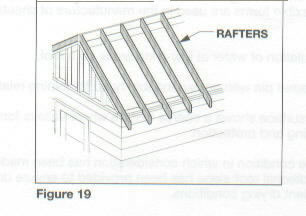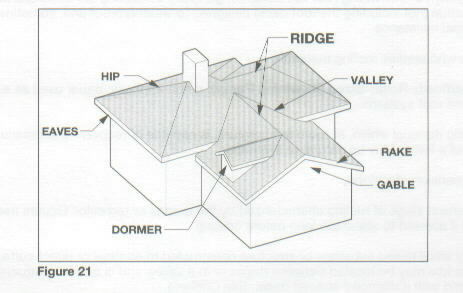Glossary of Roofing and Waterproofing Terms
R
A B C D E F G H I JK L M N OP R S T UV W-Z
R-Value: the resistance to heat transfer of a material. Insulators have relatively high R values. Units are °F.Ft2.Hr/Btu.
Racking: a method of asphalt shingle application, also referred to as the straight-up method, whereby shingle courses are applied vertically, up the roof rather than laterally or across and up.
Rafter: one of a series of sloped structural members, that extend from the ridge or hip to the downslope perimeter or cave, designed to support the roof deck and its associated loads. (See Figure 19.)
Raggle: a groove or slot, often cut in a masonry wall or other vertical surface adjoining a roof, for inserting an inset flashing component such as a regret.
Rake: the sloped edge of a roof at or adjacent to the first or last rafter. (See Figure 20.)
Rake-Starter (Bleeder Strip): starter-strip used along rake edges in conjunction with asphalt shingle roofing.
RCI: Roof Consultants Institute
RCMA: Roof Coatings Manufacturers Association
RDCA: Roof Deck Contractors Association
Re-Cover: the addition of a new roof membrane or steep-slope roof covering over a major portion of an existing roof assembly. This process does not involve removal of the existing roofing.
Reflectivity: see Light Reflectance.
Reglet: a sheet metal receiver for the attachment of counterflashing. (A regret may be inset into a raggle, embedded behind cladding, or be surface mounted.)
Reinforced Membrane: a roofing or waterproofing membrane that has been strengthened by the addition or incorporation of one or more reinforcing materials, including woven or nonwoven glass fibers, polyester mats or scams, nylon, or polyethylene sheeting.
Relative Humidity: the ratio of the weight of moisture in a given volume of air-vapor mixture to the saturated (maximum) weight of water vapor at the same temperature, expressed as a percentage. For example, if the weight of the moist air is 1 pound and if the air could hold 2 pounds of water vapor at the same temperature, the relative humidity (RH) is 50 percent.
Release Tape (or Strip): a plastic film or paper strip that is applied to the back of self-sealing shingles and other materials. The strip prevents the material from sticking together in the roll or bundle. With asphalt shingles, the strip need not be removed for application of the shingles.
Replacement: the practice of removing an existing roof system down to the roof deck and replacing it with a new roofing system.
Reroofing: the process of re-covering, or tearing-off and replacing an existing roof system.
Resin: component B in SPF. This component contains a catalyst, blowing agent, fire retardants, surfactants and polyol. It is mixed with the A component to form polyurethane.
Resistance, Thermal: the average temperature difference between two defined surfaces of a particular body or assembly when unit thermal transmission in unit time through unit area is established between the surfaces. R=°F.h~s~ft2/Btu (R=K.m2NV).
Ridge: highest point on the roof, represented by a horizontal line where two roof areas intersect, running the length of the area. (See Figure 21.)
Ridge Cap: a material or covering applied over the ridge of a roof.
Ridge Course: the last or top course of roofing materials, such as tile, roll roofing, shingles, etc., that covers the ridge and overlaps the intersecting field roofing.
Ridge Vent: a ventilator located at the ridge that allows the escape of warm and/or moist air from the attic area or rafter cavity. Most ridge vents are either premanufactured metal or flexible, shingle-over type.
Ridging: see Buckle.
RIEI: Roofing Industry Educational Institute
RMA: Rubber Manufacturers Association
Roll Goods: a general term applied to rolls of roofing felt, ply sheet, etc., which are typically furnished in rolls.
Roll Roofing: smooth-surfaced or mineral-surfaced, coated, prepared felts.
Roof Assembly: an assembly of interacting roof components (includes the roof deck, vapor retarder [if present], insulation, and roof covering).-
Roof or Roofer's Cement: see Asphalt Roof Cement or Coal Tar Roof Cement.
Roof Covering: the exterior roof cover or skin of the roof assembly, consisting of membrane, panels, sheets, shingles, tiles, etc.
Roof Curb: raised frame used to mount mechanical units (such as air conditioning or exhaust fans), skylights, etc.
Roof Diaphragm: a structural roof deck that is capable of resisting shear that is produced by lateral forces, such as wind or seismic loads.
Roof Jack: a metal bracket used to support toe-boards on steep-slope roofs. (Also see Flashing Collar.)
Roof Overhang: a roof extension beyond the exterior wall of a building.
Roof Seamer: machine that crimps neighboring metal roof panels together, or that welds laps of membrane sheets together using heat, solvent, or dielectric energy.
Roof Slope: the angle a roof surface makes with the horizontal, expressed as a ratio of the units of vertical rise to the units of horizontal length (sometimes referred to as run). For English units of measurement, when dimensions are given in inches, slope may be expressed as a ratio of rise to run, such as 4:12, or as a percent.
Roof System: a system of interacting roof components, generally consisting of membrane or primary roof covering and insulation (not including the roof deck) designed to weatherproof and, sometimes, to improve the building's thermal resistance.
Roofer: craftsman who applies roofing materials.
Rosin Paper (specifically Rosin-Sized Sheathing Paper): a non-asphaltic paper used as a sheathing paper or slip sheet in some roof systems.
Rubber: a polymeric material which, at room temperature, is capable of recovering substantially in shape and size after removal of a force. May be natural or synthetic.
Run: horizontal dimension of a slope.
Rust Blush: the earliest stage of rusting characterized by the orange or red color. Occurs frequently on freshly sand blasted steel if allowed to stand too long before coating.


